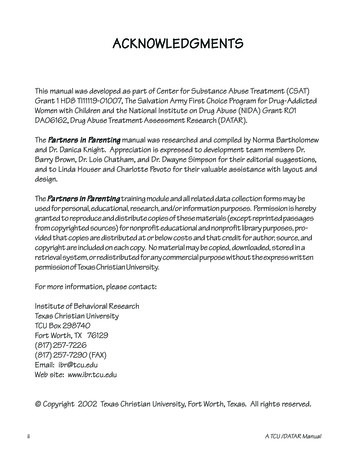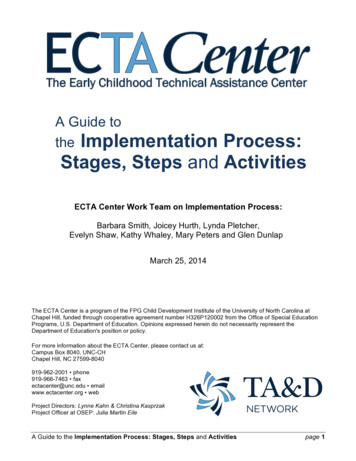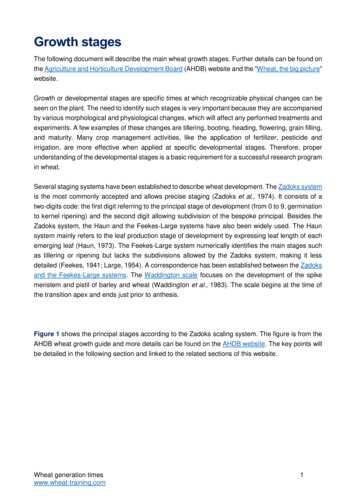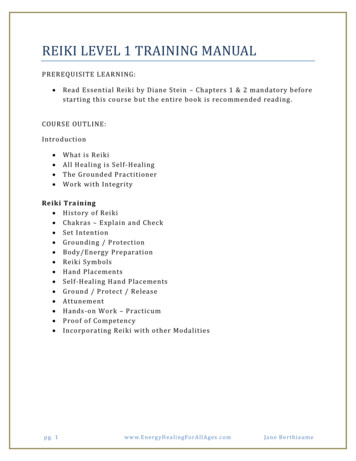
Transcription
ACKNOWLEDGMENTSThis manual was developed as part of Center for Substance Abuse Treatment (CSAT)Grant 1 HD8 TI11119-01007, The Salvation Army First Choice Program for Drug-AddictedWomen with Children and the National Institute on Drug Abuse (NIDA) Grant R01DA06162, Drug Abuse Treatment Assessment Research (DATAR).The ParartnersPararentingtners in Parenting manual was researched and compiled by Norma Bartholomewand Dr. Danica Knight. Appreciation is expressed to development team members Dr.Barry Brown, Dr. Lois Chatham, and Dr. Dwayne Simpson for their editorial suggestions,and to Linda Houser and Charlotte Pevoto for their valuable assistance with layout anddesign.tners in Parenting training module and all related data collection forms may beThe ParartnersPararentingused for personal, educational, research, and/or information purposes. Permission is herebygranted to reproduce and distribute copies of these materials (except reprinted passagesfrom copyrighted sources) for nonprofit educational and nonprofit library purposes, provided that copies are distributed at or below costs and that credit for author, source, andcopyright are included on each copy. No material may be copied, downloaded, stored in aretrieval system, or redistributed for any commercial purpose without the express writtenpermission of Texas Christian University.For more information, please contact:Institute of Behavioral ResearchTexas Christian UniversityTCU Box 298740Fort Worth, TX 76129(817) 257-7226(817) 257-7290 (FAX)Email: ibr@tcu.eduWeb site: www.ibr.tcu.edu Copyright 2002 Texas Christian University, Fort Worth, Texas. All rights reserved.iiA TCU /DATAR Manual
AppendixList of Supplemental Reading MaterialsPageIowa State University – University Extension ServiceUniversityUniversityServiceAges and Stages Series1-12 Months . 19912-18 Months . 20318-24 Months . 2052-Year-Olds . 2073-Year-Olds . 2094-Year-Olds . 2115-Year-Olds . 2136-8 Years . 2159-11 Years . 217Preteen, Young Teen Development . 219ChildrenUnderstanding Children SeriesToys . 221Sibling Rivalry . 225Language Development . 229Learning to Read and Write . 233Disciplining Your Preschooler . 237Disciplining Your Toddler . 241Fears . 245Self-Esteem . 249Moving to a New Home . 253Temper Tantrums . 257Biting . 261Toilet Training . 265Children and Sleep . 269Childhood Stress: What Parents Can Do . 271All articles referenced above appear by permission of University Extension Service, Iowa State University, Ames, Iowa.Available: http://www.extension.iastate.edu/pubs/ch.htm Downloaded and printed: 3/21/2000 and 8/6/02.Partners in Parenting197
1-12MonthsBabies learn and grow so quickly. By the end of this yearyour baby will have almost tripled in size. He or she willbe crawling and maybe even taking a timid first step! Tryto spend lots of time holding, cuddling, and playing withyour little one. You will be richly rewarded with babbles,smiles, and squeals of laughter.By 4 monthsPhysical development weight: 10-18 pounds length: 23-27 inches sleeps about 6 hours beforewaking during the night sleeps 14-17 hours daily lifts head and chest whenlying on stomach holds both eyes in afixed position follows a moving object orperson with eyes grasps rattle or finger wiggles and kicks with armsand legs rolls over (stomach to back) sits with supportMental development explores objects with mouth plays with fingers, hands,toes reacts to sound of voice,rattle, bell turns head toward brightcolors and lights recognizes bottle or breast Baby proof everything! Store toxic substances such as dishwasher detergent, make-up, paint, or medicine up high. Putsafety latches on cabinets, and covers on electrical outlets.Lower crib mattresses so an older infant can’t fall over therail. Cover sharp corners of tables or shelves that your infantmight bump into. Provide interesting objects for baby to mouth and explore.Square nylon scarves, plastic measuring cups, large woodenspoons, and colorful washcloths are favorite household toys.Keep easy-to-swallow objects out of infant’s reach. Babyshould not be allowed to play with anything smaller than ahalf dollar (about 1 1/4 inch). If your baby is bottle fed, be sure to hold him or her whilefeeding. Even if your baby holds the bottle, being held andcuddled helps develop a strong nurturing parent-child relationship. Do not prop an infant drinking from a bottle as itmay cause choking. Respect your baby’s natural schedule. Most babies will settleinto a regular routine for eating, sleeping, and soiling theirdiapers, but the schedule will vary depending on the baby.Some babies need to eat more frequently than others. Somewill sleep through the night early on, others will continue towake briefly well into their second year. Talk to your baby. Face your infant when talking so he orshe can see you and smile with you. Talk about what you aredoing, familiar objects, or people. You may even want to(continued on page 3)PM 1530A Revised March 2001Partners in Parenting199
(4 months cont.)Social and emotionaldevelopment cries (with tears) to communicate pain, fear, discomfort,or loneliness babbles or coos loves to be touched andheld close responds to a shaking rattleor bell returns a smile responds to peak-a-boogamesBy 8 monthsPhysical development weight: 14-23 pounds length: 25-30 inches first teeth begin to appear drools, mouths, and chewson objects reaches for cup or spoonwhen being fed drinks from a cup with help enjoys some finely chopped,solid foods closes mouth firmly or turnshead when no longer hungry may sleep 11-13 hours atnight although this variesgreatly needs 2-3 naps during theday develops a rhythm for feeding, eliminating, sleeping,and being awake true eye color is established rolls from back to stomachand stomach to back sits alone without supportand holds head erect raises up on arms and kneesinto crawling position; rocksback and forth, but may notmove forward200 uses finger and thumb topick up an object shows distress if toy istaken away transfers objects from onehand to the other hair growth begins to coverhead squeals, laughs, babbles,smiles in response likes to be tickled andtouchedMental development smiles at own reflection inmirror cries in different ways to sayhe or she is hurt, wet, hungry, or lonely makes noises to voice displeasure or satisfaction recognizes and looks forfamiliar voices and sounds learns by using senses likesmell, taste, touch, sight,hearing focuses eyes on small objectsand reaches for them looks for ball rolled out ofsight searches for toys hiddenunder a blanket, basket, orcontainer explores objects by touching,shaking, banging, and mouthing raises arms as a sign to beheld recognizes family membernames responds to distress of othersby showing distress or crying shows mild to severe stressat separation from parentBy 12 monthsPhysical development weight: 17-27 pounds babbles expressively as iftalking enjoys dropping objects overedge of chair or crib length: 27-32 inches sleeps 11-13 hours at night;but may still wake up duringthe night takes naps—some babies willstop taking a morning nap,others will continue bothmorning and afternoon naps begins to refuse bottle or weanself from breast during daySocial and emotionaldevelopment needs at least 3 meals a daywith 2 snacks in-between enjoys drinking from a cup responds to own name shows fear of falling off highplaces such as table or stairs spends a great deal of timewatching and observing responds differently tostrangers and familymembers shows fearfulness towardstrangers; is friendly tofamily members imitates sounds, actions,and facial expressions madeby others begins to eat finger foods continues to explore everything by mouth enjoys opening and closingcabinet doors crawls well pulls self to a standingposition stands alone holding ontofurniture for support walks holding onto furnitureor with adult helpA TCU/DATAR Manual
Mental development says first word says da-da and ma-maor equivalent “dances” or bounces to music pays attention toconversations claps hands, waves bye,if prompted likes to place objects insideone another interested in picture booksSocial and emotionaldevelopment copies adult actions such asdrinking from a cup, talkingon phone responds to name likes to watch self in mirror expresses fear or anxietytoward strangers(continued from page 1)babble back or echo sounds your baby makes much as youwould in a regular conversation. Even though your infantcannot understand everything you say, he or she will belearning many words that will form the basis for languagelater on. Read to your baby. Babies enjoy cuddling on a parent’s lap,looking at colorful picture books, and hearing the rhythm ofa parent’s voice. With time they begin to understand thatwords have meaning and can be used to identify objects. Encourage older infants to feed themselves by offeringpieces of banana and soft bread. Give your baby a spoonwith some mashed potatoes or other sticky food and let himor her practice eating with a spoon. Yes, it will be messy! Bepatient. Learning this skill takes lots of practice! Play peek-a-boo. Hide your face behind a blanket, then peekout at your baby. Older babies will learn to do this themselves and will enjoy this game for a long time. Give your baby the freedom to move around. Young infantsenjoy being on their back so they can kick, wiggle, and lookaround. Older infants need space and time to practicecrawling, creeping, pulling up, and walking. Spending toomuch time in a walker, play pen, or infant swing may inhibit the development of these important skills. Help your baby develop a sense of trust and security byresponding to baby’s cries. Feeling secure encourages yourbaby to try new things. Be consistent so your baby knowswhat to expect. Stay with your baby when someone new is around. Encourage strangers to approach slowly. Introduce your infant,and let him or her explore someone new in the safety ofyour presence.Partners in Parenting wants caregiver or parent tobe in constant sight offers toys or objects toothers, but expects them tobe returned may become attached to afavorite toy or blanket pushes away something heor she does not wantToys pictures on wall mobile of bright andcontrasting colors measuring cups crib mirror rattles that make a varietyof sounds musical toys xylophone bath toys spoons pounding bench balls of different sizes stacking rings board or cloth books large plastic cars, trucks soft, washable dolls oranimals201
Books for parentsTouchpoints: Your Child’s Emotional and Behavioral Development, T.Berry BrazeltonThe First Twelve Months of Life: Your Baby’s Growth Month by Month,Frank CaplanWhat to Expect the First Year, Arlene Eisenberg, Heidi Murkoff andSandy HathawayYour Baby and Child, From Birth to Age Five, Penelope LeachThe Baby Book: Everything You Need to Know About Your Baby fromBirth to Age Two, William Sears and Martha SearsCaring for Your Baby and Child - Birth to Age Five, American Academy ofPediatrics. Steven P. Shevlov, ed.Books for childrenBaby’s Faces, Ben ArguetaThe Rock-A-Bye Collection (audio tape and book), J. Aaron Brown &Associates, Inc.Teddy In The House, Lucy CousinsTouch and Feel: Baby Animals, DK PublishingGrow! Babies!, Penny GentieuAnimal Babies, Harry McNaughtHide and Seek Puppies, Roy VolkmannA word on developmentYour child is unique. His or her learning andgrowth rates differ from other children the sameage. If, however, your child is unable to domany of the skills listed for this age group, youmay wish to talk to an early childhood specialist. You are the best person to notice developmental problems, if any, because of the timeyou spend with your child. If your child hasspecial needs, early help can make a difference.If you have questions about your child’s development or want to have your child assessed, contact: Your pediatrician or health care professional Area Education Agency—Early ChildhoodSpecial Education Department Iowa Compass 1-800-779-2001.Contact your county Extension office to obtainother publications about children, parenting,and family life or visit the ISU Extension Website at http://www.extension.iastate.edu/Pages/pubs/.The developmental information provided in this bulletinhas been compiled from a variety of professional resourcesto help you understand your child’s overall growth. It is nota standardized measurement tool.File: Family life - 8Written by Lesia Oesterreich, extension family lifespecialist. Edited by Muktha Jost. Graphic designby Valerie Dittmer King.202. . . and justice for allThe U.S. Department of Agriculture (USDA) prohibitsdiscrimination in all its programs and activities on the basisof race, color, national origin, gender, religion, age,disability, political beliefs, sexual orientation, and marital orfamily status. (Not all prohibited bases apply to allprograms.) Many materials can be made available inalternative formats for ADA clients. To file a complaint ofdiscrimination, write USDA, Office of Civil Rights, Room326-W, Whitten Building, 14th and Independence Avenue,SW, Washington, DC 20250-9410 or call 202-720-5964.Issued in furtherance of Cooperative Extension work, Actsof May 8 and June 30, 1914, in cooperation with the U.S.Department of Agriculture. Stanley R. Johnson, director,Cooperative Extension Service, Iowa State University ofScience and Technology, Ames, Iowa.A TCU/DATAR Manual
12-18 MonthsThe second year is a delightful time for parents andchildren. Your baby is developing a personality andrewards your time together with laughter, funnyfaces, and affectionate hugs. First steps and firstwords are exciting family events.Physical development weight: 17-30 pounds height: 27-35 inches crawls well stands alone, sits down gestures or points to indicatewants likes to push, pull, anddump things pulls off hat, socks, andmittens turns pages in a book stacks 2 blocks likes to poke, twist, and squeeze enjoys flushing toilets andclosing doors enjoys carrying small objectswhile walking, often one in eachhand holds crayon and scribbles, butwith little control waves bye-bye and claps hands walks without help enjoys holding spoon wheneating, but experiences difficulty in getting spoon intomouth Enjoy some “floor time” with your child each day. Crawl aroundtogether, play peek-a-boo behind the sofa, or roll a ball back andforth. Your child will love having you down on his or her level. Review your baby proofing. Your child’s increasing growth andmobility make it possible to reach unsafe heights and play withdangerous material. Get down on your knees in each room andlook at things from your child’s perspective. Put toxic items likepaint, dishwashing detergent, medicine, and make-up in highcupboards, preferably with a safety cabinet latch. Put together a box of items that are fun to feel, poke, and squeeze.You might include plastic margarine tubs, an old sock, tissuepaper to crumple, measuring cups of different sizes, a turkeybaster, a nylon scarf, an egg carton, and paper cups. Choose itemslarger than a half-dollar to avoid choking hazards. Relax and have fun dancing to music with your child. Use bath time to point to some body parts and say them with yourbaby. Nose, ears, arms, legs, tummy, toes. Talk frequently to your child to increase his or her language skillsand encourage cooperation. You can make dressing time more funby pointing to and identifying body parts and clothes. For instance,“See this pretty red shirt? The shirt goes over your head. Yourarms go into the sleeves. What shall we put on your legs?” Around 18 months your child may begin clinging and become anxiousabout being separated from you. If possible, reduce separations andbe sure that your child is cared for by someone familiar. rolls a ball to adult on requestPartners in ParentingPM 1530B Revised May 2001203
Mental development says 8-20 words you can understand looks at person talking to himor her says “Hi” or “Bye” if remindedBooks for parents identifies object in a bookYour Baby and Child, From Birth to AgeFive, Penelope LeachCaring for Your Baby & Young Child, Birthto Age Five, American Academyo
Partners in Parenting 197 Appendix List of Supplemental Reading Materials Page Iowa State University – Uni











